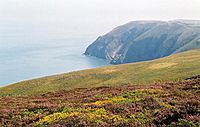Exmoor Coastal Heaths facts for kids
| Site of Special Scientific Interest | |
 |
|
| Area of Search | Somerset & Devon |
|---|---|
| Coordinates | 51°12′52″N 3°58′38″W / 51.21448°N 3.97719°W |
| Interest | Biological |
| Area | 1,758.3 hectares (17.583 km2; 6.789 sq mi) |
| Notification | 1994 |
The Exmoor Coastal Heaths is a very special natural area in Devon and Somerset, in the United Kingdom. It covers a huge area of about 1758.3 hectares, which is like 4,344 football fields! This place was officially recognized as a "Site of Special Scientific Interest" (SSSI) in 1994.
Being an SSSI means it's a really important place for nature. It has unique plants, animals, or geological features. The government protects these sites to make sure they stay healthy for future generations.
Contents
What Makes Exmoor Coastal Heaths Special?
This amazing area is part of the Exmoor National Park. It's known for its large areas of heathland. Heathland is an open, wild landscape, often with low-growing plants like heather. It's a beautiful sight, especially when the heather is in bloom.
Where Can You Find These Heaths?
The Exmoor Coastal Heaths are not just one big block. They are made up of four separate sections. These sections stretch along the coast between Combe Martin and Minehead. The main parts are around places like Trentishoe, Cosgate Hill, Countisbury, and North Hill.
Amazing Plants You Can Find
The coastal areas and woodlands here are home to many rare plants. Some of these plants are found almost nowhere else in the country!
For example, there are two types of whitebeam trees. These are special because they are endemic to this area. This means they naturally grow only here and nowhere else in the world! Their scientific names are Sorbus subcuneata and Sorbus vexans.
You can also find other rare plants:
- White mullein (Verbascum lychnitis): This plant has pretty yellow flowers. It grows in fields near the edge of the heaths.
- Cornish moneywort (Sibthorpia europaea): You might spot this small plant growing next to streams.
- Rock stonecrop (Sedum forsteranum): This plant likes to grow on rocky cliffs by the sea.
- Sea storksbill (Erodium maritinum): This plant, along with upright chickweed (Moenchia erecta) and bird's-foot clover (Trifolium ornithopodioides), grows in areas where the grass is very short.
Cool Animals Living Here
It's not just plants that make this place special! The Exmoor Coastal Heaths are also home to a very rare butterfly. This is the high brown fritillary (Argynnis adippe). This beautiful butterfly is nationally rare, meaning there are very few of them left in the country. Protecting its home here helps it survive.

